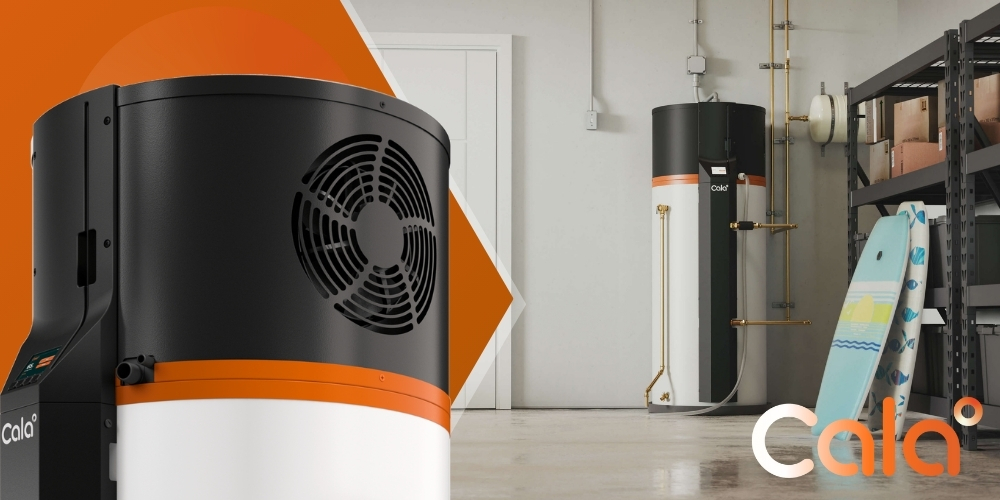Custom Residential Duct Design: Why Manual D Matters

Intelligent Heat Pump Water Heaters for Massachusetts Residential Homes — Why SumZero Selects Cala
By SumZero Energy Systems — Massachusetts’ #1 Heat Pump Installation Team
Picking a new water heater once involved a simple decision between gas and standard old electric, praying the hot water wouldn't be gone when there were two showers in a row. That's no longer the case. Now, the ideal solution for the majority of Massachusetts homes is a smart heat pump water heater (HPWH). This isn't the typical hybrid of which you might have heard, but a rather new breed of unit that adapts to your home's schedule, accommodates your energy usage, and maintains comfort consistently while consuming a lot less energy.
When homeowners want to have it exactly right the first time, our team is discerning about what products we choose. We consider the landscape and inspect the details before determining that they might work with Cala, a company that produces a high-technology hot water heater that modern homes need: intelligent, consistent, and efficient hot water — installed properly. This article describes why this alliance matters, how the tech benefits your home, what you should expect from our installation, and the handy information (rebates, credits, fit questions) homeowners inquire about daily.
Why This Alliance Is Important
(and What It Does for You)
There are two parts to a successful hot water solution:
Great technology
A system that makes you comfortable and uses less energy.
Great installation
Design, placement, airflow, electrical, condensate handling, commissioning, and long-term support.
Cala provides a tailor-built, smart HPWH platform. SumZero provides actual-world experience so that it works perfectly in real Massachusetts homes.
Together, we provide three things homeowners report wanting:
Accurate hot water at peak periods without guessing.
Cheaper monthly energy bills without compromise on comfort.
It is a future-proof solution that addresses the trend towards greener, all-electric homes.
Simply put: We get hot water. We know how to properly install heat pump technology. This combination makes a water heater upgrade a smart, long-term decision.
The Homeowner's Dilemma That We Are
If you have had a gas or a typical electric water heater, then you know the problems:
Hot-cold swings on hectic morning routines.
Higher electricity bills than hoped for.
No real insight, no real control.
A replace cycle that is experienced as "buying the same thing again."
Typical hybrid: Heat pump water heaters perform better, yet they still react: They delay until the tank cools off, then warm it up again. Homeowners averred they desire a system which thinks ahead—a unit which is a breeze to operate, handles peak load graciously, and does not make them compromise.
They fill that gap, which is why we work with them.

Why a Smart HPWH is Different
A standard electric water heater makes heat by passing an electric element, a giant toaster coil, through the tank. A heat pump water heater does it another way: it takes heat from the air it lives in and puts it into the water. Because it costs less energy to move heat than create it, heat pump water heaters run on much less power than typical electric ones. And they avoid burning gas, venting, and pollution.
A smart HPWH goes one step further:
It adapts to your home's schedule (morning showers, nighttime laundry) and preheats when demand isn't yet high.
You can use the app to check, plan, or increase hot water whenever you want.
It has a compressor that can change speed to fit what you need (not just "on/off").
It is achievable with a mixing valve holding water at the proper warmth for improved efficiency and then providing a sustained, safe warmth for usage. This is also possible with the availability of additional warm water at peak usage times.
It goes nicely with a contemporary home — primed for solar, time-of-use, and information you can view at a glance.
Result: more stable comfort, less energy use, improved control.
Why a Smart HPWH is Different
From what is visible on-site, there are three things certain for homeowners regarding the points of Cala:
1) Ease That Is Effortless
Consistent hot water at peak use is the ultimate test. Through forecasting demand and using a mixing valve, Cala maintains a steady supply. That results in less "uh oh" when two showers coincidentally happen at once or someone turns on the dishwasher.
2) Controls That You'll Ever Use
App functionality is key when done properly. You can check if there's hot water, turn up the heat for guests, view energy usage history, or simply set it and leave. As installers, we appreciate performance data — it allows us to address little issues before large ones form.
3) Future-Ready from Day One
Massachusetts is going towards clean, electricity-based homes. Cala's strategy combines well: it is scalable for solar power and accounts for time-of-use rates when needed. If you foresee solar energy at some time, or already have it, this water heater won't stop your home from being efficient.
4) A Company That Stands Behind Its Product
Cala backs every unit with a 10-year parts warranty and 3-year labor warranty — a strong sign they stand behind both the technology and the people who install it. At SumZero, we respect that kind of commitment because it mirrors our own approach: taking care of homeowners and supporting our partners with the same level of trust and accountability.
What SumZero Offers As Your Installer
(Why It Matters)
Even the best system won't work so great if installed wrong. Our task is getting your new HPWH working perfectly inside your home, not on a drawing board. This is what our approach is:
Right-size design.
We measure how much water your home needs and discuss the high-flow fixtures, filling bathtubs, and washer usage.
Best installation and ventilation.
HPWHs require air to make the heat move. We consider the room size, doors, vents, and — when necessary — ducting solutions for high performance and low noise.
Clean handling of electricity and condensate.
Safe power, tidy routing, and a trustworthy drainage plan are essential.
Commissioning correctly.
We don't just "turn it on." We verify performance, position the mixing valve, help you with the app, and verify your comfort objectives.
Rebates, credits, and financial assistance.
Mass Save, federal 25C, and the 0% HEAT Loan (if applicable) — we'll help you with that.
We take special care.
Our teams respect your home, protect your floors, and leave the place nicer than they found it.
Aftercare you can count on. Questions years down the road? We're here. The whole concept of a smart system is long-term confidence, not a one-day installation.
Costs, Incentives, and Lifetime Value
Two parts matter here: upfront cost and operating cost.
→ It is a better unit than a standard electric or simple hybrid. Tax credits and rebates make a big difference. A lot of Massachusetts homeowners rely on the 0% HEAT Loan for easier payments.
→ Month after month, the intelligent HPWH's effectiveness is where the value lies. By transferring (not creating) heat and by scheduling heating intelligently, homeowners consistently experience significant decreases in water-heating energy consumption — particularly relative to resistance electric, and many times relative to gas or delivered fuels when full costs are factors.
If you'd like figures specific to your home (household number, showering usage, energy costs), we'll do the math at your consult and provide you with a clear estimate of payback, lifetime cost saving, and the rebates for which you qualify.
Are Smarter Heat Pump Water Heaters Good for Your Home?
It is feasible for many Massachusetts homes. We will cover:
→ Household size and routines. Families with up to about 5 people usually do well with the standard setup; we will give advice for larger families or special situations.
→ Space and ventilation. We check the space, door vents, or ducts if necessary, and ventilation so the system operates properly.
→ Location. Basements are typical, as are utility rooms. As the unit functions, it removes air that feels like a dehumidifier — a typical plus for basements.
→ Electrical. We check panel capacity and proper wiring; no installation day surprises.
→ Future plans. Now or in the future for solar? Time-of-use rates? We'll put the system on so it grows with your home.
[[cta-heatpump]]
Why Is Cala Different from "Traditional Hybrids"?
✪ Control and Convenience:
Cala integrates intelligent tech with a mixing valve to remain comfortable, even when it is busy. Most standard hybrid units have simple modes and react only when the tank becomes chilled.
✪ Care and Trust:
Performance insights help you recognize problems early on and keep you on your feet for surprises. Traditional deployments are mostly "wait and see."
✪ Timing and Efficiency:
Variable driving and improved scheduling assist in energy saving with the maintenance of comfort. Ordinary hybrids operate more often and at undesirable times.
✪ Future-Ready
The design of the Cala accommodates with solar power, intelligent homes, and plans for utilizing electricity. Most older hybrids were not built for that usage.

What to Expect with SumZero
(From the First Call Through the First Shower)
✪ Talk & Pictures
We'll first glance at your objectives and take some fast photos of the current installation: the water heating unit, panel, and surrounding room.
✪ Right-Fit Design
We fit your hot water consumption and available spaces to a design which we endorse.
✪ Chaplain: A Comprehensive
Your quote is going to be transparent, includes information for installation, accessories, and a checklist for incentives. The paperwork assistance takes care of our end.
✪ Professional Installation
Licensed, insured, and detail-orientated. We dispose of the old unit, prepare the site, install and commission a new system, and leave the site tidy.
✪ App Introduction and Instructions
You'll discover how to see hot water supply, schedule increases, and view consumption — without being "technical."
✪ Support and Help
We're your long-term partner. Got a question? You call us — that's what homeowners deserve from the #1 heat pump installation company.
Common Questions We Get
(And Easy Answers)
Smart heat pump water heaters move heat from the surrounding air into the water instead of generating heat directly. This makes them up to three to four times more efficient than standard electric models. Cala’s intelligent system takes it further — it learns your household’s patterns, preheats before busy periods, and gives you app-based control to monitor or boost hot water anytime.
Most hybrid water heaters react when the tank cools. Cala predicts when your home will need hot water and heats proactively, saving more energy while maintaining comfort. It also features a variable-speed compressor, integrated mixing valve, and performance monitoring portal, giving both homeowners and installers a smarter, more reliable experience.
Savings depend on your energy source and usage, but many Massachusetts homeowners cut their water-heating costs by 50–70% when switching to a heat pump system. Cala’s intelligent controls add even greater efficiency. Add Mass Save® rebates, federal 25C tax credits, and potential 0% HEAT Loan financing, and most families see real payback within just a few years.
Yes — most Massachusetts homes are a great fit. Cala’s 65-gallon design comfortably serves households up to five people and can prepare up to 90 gallons ahead of peak use. The system needs adequate space and airflow, similar to a dehumidifier, and our team at SumZero handles every detail — from placement and ducting to electrical and performance checks.
SumZero Energy Systems is Massachusetts’ #1 heat pump installation team, trusted for precision, transparency, and high-quality service. We manage every step — design, installation, rebate paperwork, app setup, and long-term maintenance — so homeowners enjoy smarter comfort and lasting confidence. With SumZero, you’re not just buying equipment; you’re gaining a partner who stands behind it.
Why We Feel Secure Recommending This to Massachusetts Homeowners
We have a simple promise: we only install solutions that we would use in our own homes. Cala’s approach — being smart, having control, and being ready for the future — matches what we have learned from many talks with homeowners in the state. Together with SumZero’s careful installation standards and ongoing support, this water-heating upgrade makes sense right away and will last well with your home. Cleaner heat. Smarter comfort. Fewer bills.
Ready to Take the Next Step?

To learn more about Cala’s technology and vision, visit Cala Systems.
Why Manual D is Essential for Efficient HVAC Ductwork in Massachusetts Homes
Ensuring your home's heating and cooling system runs smoothly starts with what’s behind the walls—your ductwork. Custom residential duct design done according to Manual D standards isn't just a technical concern, it's the key to better performance, comfort, and lower utility bills. For many Massachusetts homeowners, understanding the value of properly designed HVAC ductwork can unlock long-term savings and a healthier living environment.
Most homes lose 20 to 30 percent of their conditioned air due to poor duct design and leakage. This means higher bills and less comfort—even if your system is new or high-efficiency.
Let’s explore how Manual D-based designs affect your system’s efficiency, where ductwork installation can go wrong, and how Massachusetts homeowners can keep their homes efficient and cozy year-round.
How Custom Ductwork Design Prevents Common Airflow Problems
Think of your duct system as the breathing passages of your home. If air can’t flow freely and evenly to every room, your system has to work harder, costing you more and wearing out faster. Custom duct design using Manual D ensures your system is tailored to your home’s layout, not a one-size-fits-all template.
Ductwork Installation: Why One Size Doesn’t Fit All
Massachusetts homes vary from old Victorians to modern builds with complex floor plans. Manual D takes key factors into account:
- Square footage and room orientation
- Window placement and insulation levels
- Heating and cooling demands per zone
- Type and location of equipment (like heat pumps or gas furnaces)
Instead of guessing, the design uses data to balance airflow throughout every room in your home.
Signs Your Existing Ductwork Isn't Doing the Job
Many homeowners don’t notice poor duct design until hot or cold spots become unbearable. Watch for these issues:
- One room is always warmer or colder than the rest
- Airflow feels weak or nonexistent from some vents
- High energy bills despite an efficient system
- Loud duct noises or whistling sounds
If this sounds familiar, it might be time to look into custom ductwork installation designed specifically for your home.
A well-designed duct system can reduce HVAC energy use by up to 40 percent, according to data from the Massachusetts Clean Energy Center.
[[cta-heatpump]]
The Long-Term Value of Effective Ductwork Services
It’s tempting to focus only on your HVAC equipment and forget the ductwork that connects it all. But even a top-tier system from Mitsubishi Electric or Bosch HVAC won’t perform at its best if your ducts are struggling. Investing in ductwork services that include design improvements, sealing, or upgrades adds real value to your home's comfort and resale potential.
The Role of Duct Sealing in Energy Efficiency
Unsealed or poorly sealed duct joints allow air to escape before it ever reaches your living quarters.
Benefits of proper duct sealing include:
- Lower energy usage and reduced monthly utility costs
- Improved indoor air quality by keeping dust and allergens out
- Balanced temperature distribution throughout the house
- Reduced strain on HVAC equipment, prolonging its life
Sealing is especially important in older Massachusetts homes with aging duct systems installed before modern standards.
When to Consider Duct Replacement
There are times when sealing or patching isn’t enough. Consider duct replacement if you notice:
- Crushed or collapsed duct sections
- Rust, mold, or visible air leaks
- Extremely loud operation
- Ducts that don’t match your current HVAC output
Replacing old or incorrectly sized ducts can transform your system’s performance and help you qualify for rebates through programs like Mass Save®.
Maintenance Tips to Keep Your HVAC Ductwork in Top Shape
Once your ducts are designed, installed, and sealed correctly, the work isn’t over. Like anything in your home, your duct system needs periodic maintenance to stay efficient and healthy for your family.
Seasonal Ductwork Maintenance Checklist
To get the best from your heating and cooling system, follow this simple annual maintenance routine:
- Change air filters every 1 to 3 months
- Inspect visible ductwork for gaps or disconnections
- Vacuum vent grills and register covers
- Schedule air duct cleaning every 3 to 5 years
- Ask for a ductwork inspection during seasonal HVAC tune-ups
These steps ensure conditioned air is flowing freely and safely where it should—into your living space, not into your attic or basement.
How Proper Maintenance Protects Indoor Air Quality
Massachusetts homes face seasonal challenges like wet winters and pollen-heavy springs. Well-maintained ductwork services help prevent these contaminants from circulating through your home. This is especially important if anyone in your household has asthma or allergies.
Dirty or poorly maintained ducts can contribute to respiratory problems, especially in households with children or seniors. Keeping your duct system clean supports a healthier home environment.
When your ducts are clean, sealed, and built to Manual D specifications, your HVAC system doesn't have to fight to do its job. Instead, it works smarter—keeping your Massachusetts home comfortable in every season while controlling costs.
Whether you’re upgrading your furnace, adding a heat pump, or building a new home, prioritizing your ductwork design is not optional—it’s essential. Let comfort, efficiency, and clean air start in the spaces behind your walls.
Discover how expert HVAC ductwork installation using Manual D design can boost comfort, cut energy costs, and eliminate hot and cold spots—tailored specifically for your Massachusetts home.
Schedule Ductwork InstallationYou Might Also Like…
Continue learning with handpicked articles that inform and inspire.
Not Sure Where to Start? We’ll Guide You
Let our experts design the right heating and cooling solution—customized for your comfort, your layout, and your energy goals. No pressure. Just clarity.
Request FREE ESTIMATE









